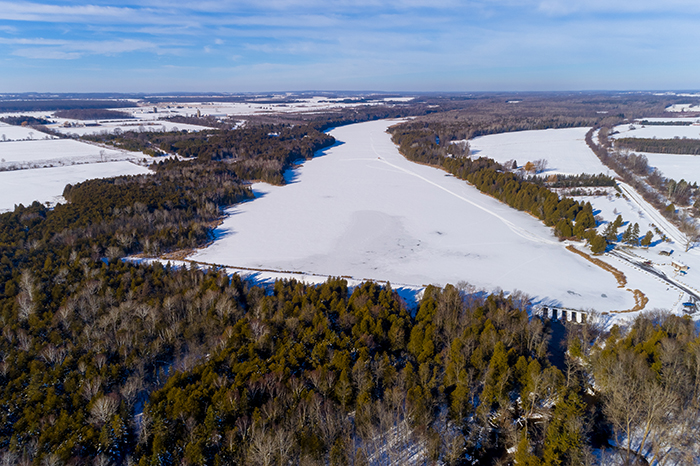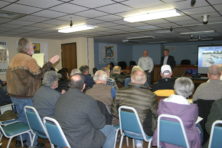Petition Circulating Against Forestville Millpond Drawdown
- Share
- Tweet
- Pin
- Share

Residents who live on the Forestville Millpond are not happy with Door County’s recently unveiled plan for a two-year drawdown of the pond beginning this fall in order to check its decline as a multi-use body of water.
A bathymetric study of the shallow, 94-acre lake found its maximum depth to be about six feet, while 92 percent of it is less than three feet deep. Sediment cores revealed one to two feet of muck on the bottom, which is easily stirred up, contributing to the lack of water clarity. The accumulated sediment was high in phosphorus, “illustrating many years of nutrient and sediment loading,” according to the county’s June 2018 report.
The report went on to state that approximately 50 percent of the nearly 18,000 acres surrounding the Ahnapee River and Silver Creek watersheds that make up the millpond are devoted to agriculture.
“An analysis of the land use, as well as computer modeling of sediment and nutrient loads, highlights the primary driver of pollutant loading as agricultural sources,” the report states.
That, say many of the millpond residents, is where the county should expend more effort – in stopping the nutrient runoff from farms.
But one of those residents, Robert Sijgers, said at the Dec. 19 meeting held at the Forestville Town Hall that when the issue of agricultural runoff was brought up, Land Conservation Committee Chair Ken Fisher told the speaker to “stop whining.”
“I was kind of flabbergasted,” Sijgers said about Fisher’s comment, which he referred to as a “ridiculous attitude” from a public official.
When people at that meeting had questions, Sijgers said the questions were never answered.
“My feeling was – and practically all the other people there was – this is not something looking for input. It’s a done deal,” he said. “I think it’s just disgusting a group of people [who] don’t even live close to it are basically making the decision.”
Sijgers said a petition is being circulated in opposition to the two-year drawdown plan. He added that most residents feel the county went for the cheapest of the 10 options offered and points out that a one-year drawdown was one of the options, but not the two-year drawdown.
“Everybody in the group, they went straight to the cheapest option. They open the sluice valve and let the water go out. It leaves you basically a small river,” he said.
The decision for the two-year drawdown was made during a joint meeting of the county Land Conservation Committee and Facilities & Parks Committee after a presentation by the county’s Soil and Water Conservation staff.
“They claim if you let the soil or mud dry out, it will lock in any pollutants,” Sijgers said. “Now that might be true. I’m investigating that claim. So far, I cannot find anywhere where they say this is a successful way they do it.”
“Our department recommendation is based on the results of the water study and input we have from resource professionals. The decision rests with the committees at this point,” said county conservationist Erin Hanson, who added, “We’re willing to work with anyone who would be impacted by the drawdown.”

Southern Door firefighters have also objected to the two-year drawdown because they use the millpond to replenish water for fighting fires. Sijgers said while that is a concern, there may be alternatives.
More important is the notion that property owners who chose to live on a shoreline will be without a lake for two years and possibly even more.
“I’m in my 70s,” Sijgers said. “The say they might have to do this every five to 10 years. With my expected life expectancy, I might be looking at a big mudhole.”
The petition that is circulating suggests that an erosion study that the Wisconsin Department of Natural Resources is planning for later this year should be completed before any decision is made on the millpond “as once the gates are opened on the dam … much sediment and nutrient overload will flush downstream, potentially causing issues in Algoma and Lake Michigan.”
The petition also calls for looking into “other less invasive options such as dredging, as well as work to secure funds to ensure a successful cleanup effort that will not be such a detriment to the community, landowners and those who enjoy using this recreational area.”
Another joint meeting of the two committees is scheduled for 8:30 am Jan. 10.



